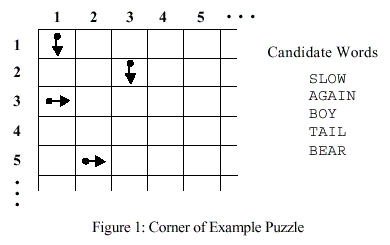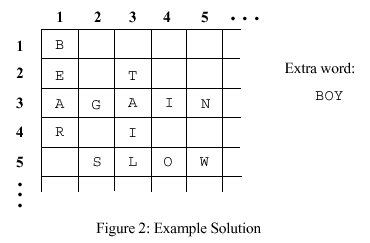
Your brilliant but absent-minded uncle believes he has solved a difficult crossword puzzle but has misplaced the solution. He needs your help to reconstruct the solution from a list that contains all the words in the solution, plus one extra word that is not part of the solution. Your program must solve the puzzle and print the extra word.
The crossword puzzle is represented by a grid with ten squares on each side. Figure 1 shows the top left corner of a puzzle. The puzzle has a certain number of “slots” where a word can be placed. Each slot is represented by the row and column number of the square where the slot begins, and the direction in which the slot extends from its initial square (“across” or “down”). The length of each slot is not specified. The puzzle has a list of candidate words, all but one of which is used in solving the puzzle.

Figure 2 shows a solution to the example puzzle in Figure 1. In a valid solution, each slot is filled with a candidate word. Every maximal horizontal or vertical sequence of two or more letters must be a word in the input. Any candidate word can be used in any slot as long as the word fits in the puzzle and does not conflict with any other word. In the example, all the candidate words are used except the word “BOY”.

The final test case is followed by a line containing the number zero.
1) Print a blank line after each trial.
2) If your uncle has made a mistake and the puzzle has no solution using the given words, print the word “Impossible”. For example, if Trial 2 has no solution, you should print “Trial 2: Impossible”.
3) If the puzzle can be solved in more than one way, print each word that can be omitted from a valid solution. The words can be printed in any order but each word must be printed only once. For example, if Trial 3 has a solution that omits the word DOG and two solutions that omit the word CAT, you should print “Trial 3: DOG CAT” or “Trial 3: CAT DOG”.
4 1 1 D 2 3 D 3 1 A 5 2 A SLOW AGAIN BOY TAIL BEAR 0
Trial 1: BOY